FantomWorks is an automotive TV reality show that has run on Discovery’s Velocity channel for 9 years. Discovery describes the show this way:
In FantomWorks restoration expert Dan Short and his team only have a heart for those who genuinely love their cars. Every car has a story, but if you can’t prove to Dan that you truly care about your car and want the job done right then he won’t accept your business. Dan’s bustling shop, FantomWorks, is the largest automotive restoration shop in America. Leaning on of years automotive restoration experience in addition to the qualities of discipline and precision Dan acquired in the military, the FantomWorks team runs a busy production pipeline in order to meticulously refurbish some of America’s favorite rides. Every week old cars come with new obstacles including irate car owners, personality clashes, cost over-runs, parts problems and walkouts.

The episode that caught our attention was the 4th season (episode 411) called “French Fried” where two young women, Stasia Charalambous and Eugina Gonzales from Virginia Beach, VA, who are part-time French can-can dancers, models and actresses, bring their 1962 2CV to FantomWorks in Norfolk, VA complaining about the
They made their impulsive purchase just seeing a photo of the car from a French mime friend. In the TV episode, Dan agrees to take on the project sorting out their issues. What transpires is more like a documentary illustrating why you want to find a qualified Citroën repair shop to work on your ducky – and NOT Fantomworks.

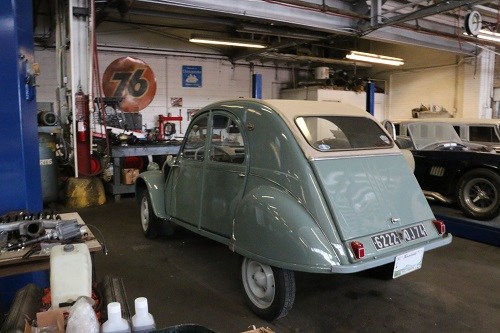
Now, we know that reality TV shows take liberties to make the episodes seem exciting, but what they showed about repairing the 2CV was not complementary to Dan Short or his workers. To anyone with even a basic knowledge of the 2CV or a rudimentary understanding of it’s engineering, they come off as idiots.
Admittedly, Dan says that they have never worked on a 2CV, but that is no excuse for not doing the basic research to understand the car before diving into it.
For starters, when Dan first test drives it, he declares that, and we quote; “Basically it is a 4 wheel drive car”. (Sorry Dan, it’s not a Sahara. That 4 x 4 version of the 2CV would be way over your head)!
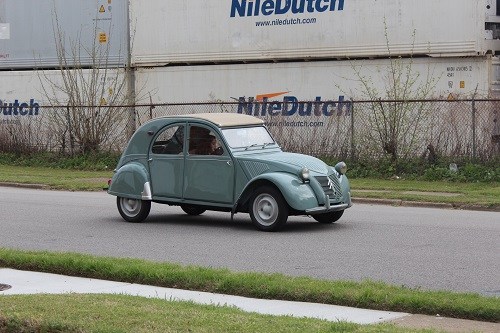
Then he expects to hit the bakes full-on and make the car screech to a halt. (And if he had managed to do that, he would have been in for a severe forward trust experience since there are no seat belts and the front seats are only anchored by 2 posts!)

He drives the car in reverse, turns the steering wheel hard the exclaims, while setting himself up for a potential rollover, that he never had a car scare the hell out of him like that. Duh! Even a properly configured 2CV is going to do that. (There’s even a youtube video showing how a 2CV can be flipped that way; https://www.youtube.com/watch?time_continue=9&v=fTE4Y_mDM50). It is well known that the 2CV is not designed to be driven in reverse quickly.
Dan then drives it back to the shop with the front wheels dragging tire marks on the road, surprised having them locked-up somewhat after putting full pressure on bakes cylinders that have probably not ever made a panic stop like that.
Once in the shop Dan and his repair guy Drew put it on the hoist, something they should have done before taking it for a test drive considering the 2CV came to them on flatbed tow truck! Poking around underneath, they don’t even know what the horizontal suspension cylinders are and how they work. Dan actually thought they were mufflers!
Speaking of mufflers, Dan inspects muffler tucked underneath, just aft of the engine, and doesn’t even notice that an opening has hacked into it for the exhaust port. The muffler is missing the exhaust tip, yet Dan points to the hole and claims the exhaust tip is in place. (At least he does understand that there is no exhaust pipe going to the rear on a 1962 2CV).
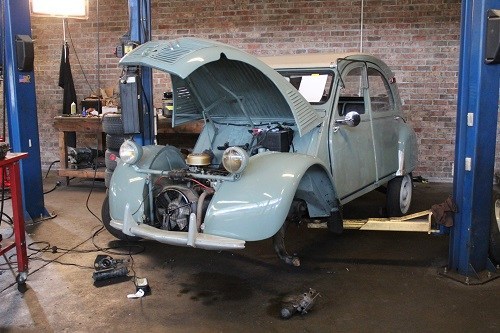
Dan and Drew show their ignorance about Citroën’s ingenious suspension dampers fitted on early 2CVs. Dan thinks they are just dead weights. Drew is a bit more in-tune thinking that they prevent suspension oscillation. In reality, they contain a coil spring and weight inside, and with a damper mounted on each wheel, the variable down-force of the weight on the spring coil inside each damper produces the effect of greater mass on the suspension arms and therefore a ride comparable to large luxury cars of the era.
While still on the rack, Dan claims that the suspension bushings are completely gone when he’s looking at the remnants of the rubber covers that fit over the rods going into the suspension springs.
Then he goes on the say that they are going to repair the hydropneumatic suspension system (of which there is none on a 2CV) and get the steering operational again.

After their trashing of Citroën engineering the repair process begins which is just about as scary as Dan and Drew’s assessment under the lift.
They show the kingpin tie-rod pivot being reamed with the handheld power drill! They further show their ignorance saying there is no wiring diagram available. You would think that someone would surf the net where it can readily be found. (Including in our Citroënvie online tech docs archive BTW).
Then they poke some fun at the French as they try to order a carb seal set, saying that the carb came from Argentina and that the French throw parts on their cars from anywhere – proving that they don’t even know a basic Solex 28IBC carburetor. Once the kit comes in from a place they found in France, (they couldn’t manage a Google search to find Kenji at 2CV Source in Seattle), they rebuild the carb from a 425 cc engine, but when showing the carburetor being installed you can hear the mechanic say he is now expecting 30 hp! Sorry pal, that engine is 18 hp and you don’t even see 30 hp in a late model 602 cc engine 2CV. (602 cc engines are 29 hp).
In the end, the
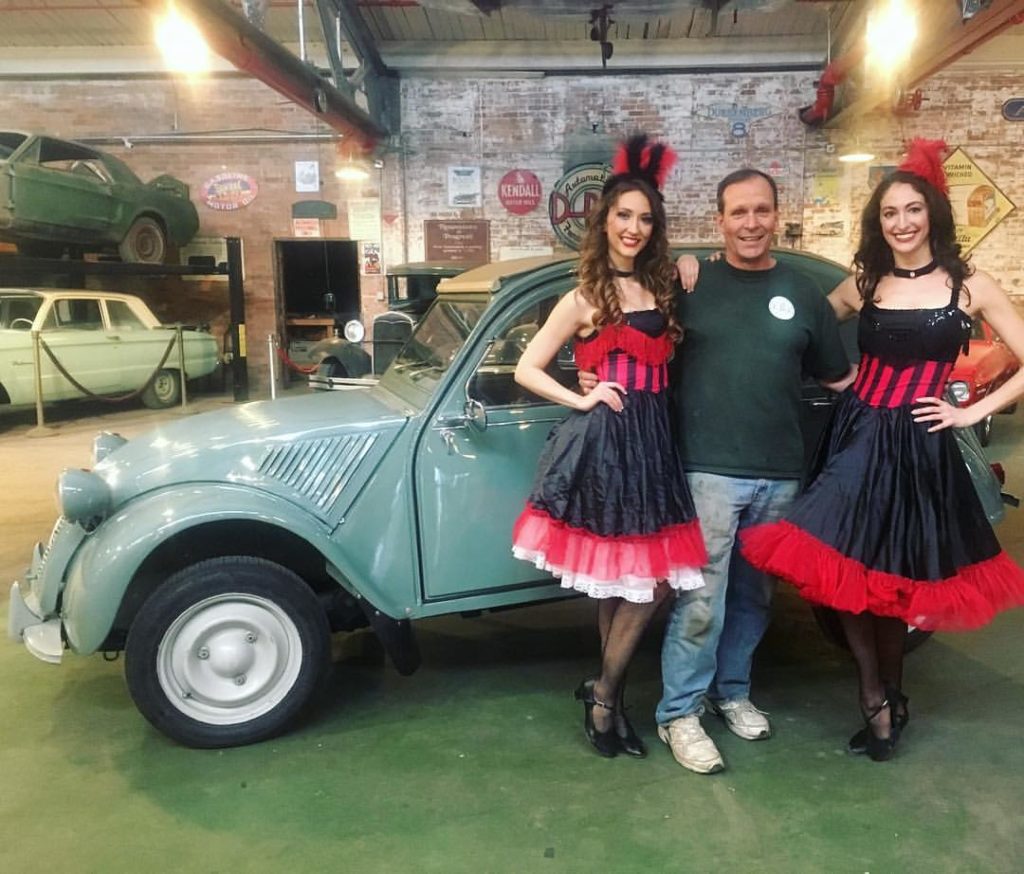
Fortunately for Citroënthusiasts who watch these type of repair shows, FantomWorks has been put on the cancellation scrapheap. Velocity, newly relaunched as MotorTrend Network, has cancelled the car restoration series. And hopefully, FantomWorks have worked on their last Citroën.
We have found the following links to the episode online, where you can watch parts 1 & 2. For some reason the videos are flipped around so that all titles are backwards and the 2CV appears to be RHD. Nevertheless, they are watchable if you can stomach their FantomWorks aptitude on the 2CV and on a 1968 Mustang convertible where they do an engine swap.
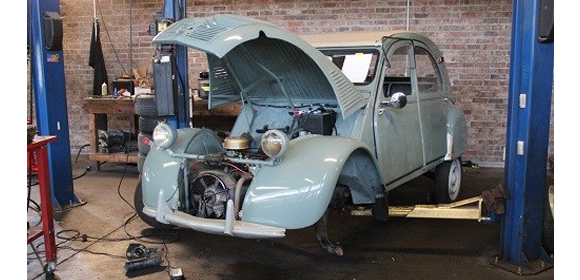

Dear George,
I don’t know why the 2Cv’s that were imported into Canada did not include a Hydropneumatic suspension but my 78 here in the states has that type of a suspension. At least the last time I looked. When I uncover it in the Spring I will look again to be sure. When I first saw that epiisode I could not believe that they did not even have a Haynes Manual to script the show by.
Great article,
Robert
Thanks for the feedback, Robert. Glad to hear you liked the article.
To clarify, all 2CVs give a bouncy ride like hydropneumatic suspension D models, but all 2CVs are spring based. The only hydraulic fluid you should find in a 2CV is the LHM that is used as brake fluid in later model 2CVs with front disc brakes. As far as the suspension is concerned, the earlier ones had a damper mounted at each wheel hub. The damper is a cylinder that inside has a lead weight sitting on a coil spring. These were on the 2CV in FantomWorks video. The later models did away with the damper and went with conventional shock absorbers (and gave a noticeably less “floaty” ride). However, all 2CVs have 2 horizontally mounted springs slung under the body, beside the frame, one on each side, and those springs slide or laterally based on the travel of the rods connected to the front and back suspension arms. The only 2CV I’m aware of with hydropneumatic suspension is a custom-built one by the Italian 2CV club about 20 years ago where they mounted a 2CV body on GS platform.
I just saw this show in the UK and as a qualified mechanic and 2CV owner was very surprised by it. I have watched other episodes on conventional cars where they did a good job – but not this time.
This time they didn’t have a clue about the tuned mass damper on the front axle or even the existence of the friction dampers on the suspension cross tubes. They just assumed it didn’t have any dampers! They clearly had no understanding of how the system works. They could have found out from the Wikipedia page! Also, don’t they have roadworthyness tests like the UK MOT test in Virginia? Some of the cars that drive in would never pass the test in the UK. My 1986 2CV has front tuned mass dampers (batteurs) and four telescopic dampers. I think back in the 50s the ripple bonnet (hood) cars had friction and batteurs front and rear, but the car on the show was supposed to be a ’62 but had a pre-60 hood. Maybe the carb they had did come from Argentina because Citroen had a plant there making 2CVs. Interestingly, tuned mass dampers are also used to stabilize skyscrapers in earthquake zones. Altering video like you noted is an attempt to avoid the copyright owners using automated software to track down and remove their copyright material when used without permission.
For people who want to know what they’re doing 2CV wise or find out if their garage like Fantomworks doesn’t, probably the best book for 2CV restoration that I know of is called ‘How to restore Citroen 2CV’ ISBN: 1-903706-44-0 by Lindsay Porter who has been a long time author for Haynes manuals. This covers older and newer models whereas the Haynes manual only covers post ’67.
Phil Hopewell
This reviewer seems a little overly-critical of Dan & FantomWorks. The Citroen was a rare car; granted the review is written on a Citroen website, but to act as if everyone has common knowledge of the cars is a little arrogant. It’s also a little ironic that while bashing someone for not knowing a lot about the car, and right after mocking Dan for mistaking the car for a 4 wheel drive version, the reviewer misspells “brakes” as “bakes”….it’s almost as though….*gasp*… people make mistakes!
Also, to criticize Fantomworks for not putting it on a lift first is a little much. Most people who are dropping a car off at a shop will have it towed in out of convenience. The owners did tell Dan that it runs and drives. It’s equally smug to go criticizing that no one knew off the top of their head that it required a “Solex 28IBC carburetor.” You can’t on the one hand talk about how rare the car is, and then on the other hand, act surprised/annoyed that people don’t know part model numbers. Pick a stance!
Maybe if “Citroënthusiasts” were a little more cognizant of the fact that not everyone knows the intricate details of these rare cars, they wouldn’t come across as so smarmy and arrogant. Also, for the record, I read that Dan was the one who opted to stop filming the tv show; not Motortrend “putting it on the cancellation scrapheap.” Additionally, the reason the titles are flipped around in the linked videos is so they don’t get caught by Youtube’s algorithm and taken down for copyright infringement. For such a know-it-all reviewer, I’m a little surprised they couldn’t figure that one out on their own.
This article was readable….if you can stomach that the author really seems to just have a dislike of a tv show, and wrote a hit-piece under the guise of a car website.
I grew with 2CVs and I adore them. I was disappointed at Fantomworks failure to research in advance. They simply didn’t get it, but then they really don’t get anything with less than 6 cylinders.